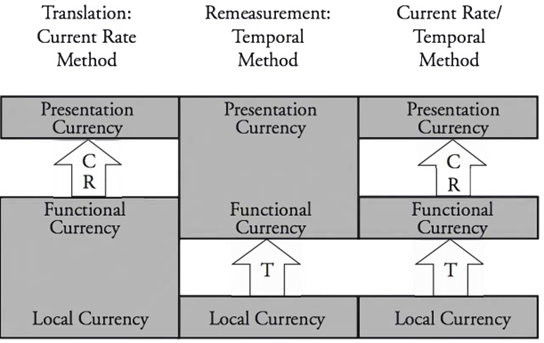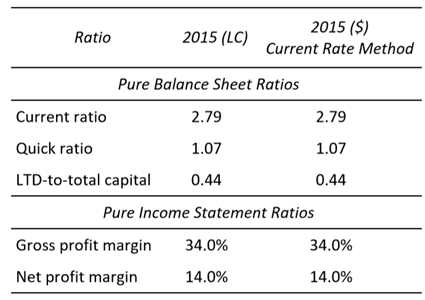Multinational Operations Accounting
When corporations do business in multiple countries, often through subsidiaries, there are currency considerations that must take place for financial reporting.
The local currency is the currency of the non-parent country we are operating in. The functional currency is the currency which the subsidiary or entity operates in. We choose the functional currency based on the when revenues and expenses are paid for the subsidiary. The presentation currency is the currency that the parent company prepares financial statements in.
There are three rate types we use to convert accounts. The current rate is the exchange rate on the balance sheet date. The average rate it is average exchange rate over the reporting period. The historical rate is the actual rate in effect when a transaction originally occurred.
There are two ways to consolidate financial statement items from the subsidiary for the parent company, if the functional and presentation currency are different. The temporal rate method, also known as remeasurement, uses primarily historical rates to translate accounts. The current rate method uses primary average rates to translate accounts.
To determine which type of translation method should be used, we look at currency structure of the multinational company. When the functional currency is the local currency, and different from the presentation currency, we use the current rate method to translate the financial statements. When the functional currency is the same as the presentation (parent) currency or is not the local currency, we use the temporal rate method for translations.

Translation and Remeasurement
Translation of income statements accounts are done at the average rate under the current rate method. All balance sheet statements other than common stock are translated at the current rate. Common stock and dividends are translated at the historical rate at time of issue. Gains and losses from translation are reported as part of shareholder’s equity, under cumulative translation adjust.
Translation of temporal accounts follows a different breakdown. Monetary assets and liabilities are remeasured at the current exchange rate. These are fixed in the amount of currency to be received or paid and include cash, receivable, payables and debt. All other assets are considered non-monetary and translated at the historical rate. This includes inventory, fixed assets, intangible assets and deferred revenue. For the income statement, expenses related to physical assets like COGS and depreciation are remeasured at a historical rate, while revenues and all other expenses are translated at a current rate. Gains and losses from remeasurement are recognized on the income statement.


Net Exposure
Under the two different translation methods, the parent companies’ currency exposure differs. When using the current method, the exposure is the net asset position or shareholder’s equity. This is because all the assets and liabilities are translated at the current rate. Under the temporal method, only monetary assets and liabilities are exposed to currency rate changes, as most other accounts are translated at historical or average rates. In other words, currency exposure is to a firm’s net monetary asset or liability.
- Exposure under current rate = shareholder’s equity
Under the temporal rate, monetary assets or liabilities can be balanced out by taking an opposite position on a non-monetary liability or asset. Under the current rate method this would be more difficult to accomplish as total asset and liabilities would need to be balanced, which would eliminate shareholder equity.
- Exposure under temporal rate = (cash + AR) – (AP + debt) =Net monetary position
Comparing Local and Parent Financial Statements
When translating financial statements from one currency to another certain financial statement accounts, and their associated ratios will change. The change in ratios depends on the appreciation or depreciation of the local currency relative to the presentation currency, and should be evident based on the fact that we must remeasure or expense currency gains and losses.
When looking at how translation will affect ratios, we must first consider that ratios that are derived from entirely from the income statement or derived entirely from the B/S will not change due to currency translation regardless of currency depreciation.

However, if the local currency is depreciating for instance, any translated I/S over B/S ratios with the B/S item in the denominator will be larger than the original untranslated ratio, and vice versa.

Hyperinflation
Hyperinflation is treated differently between IFRS and GAAP. Under GAAP, we cannot adjust non-monetary assets and liabilities to offset the impact of inflation, but under IFRS we can.
In an IFRS system, only the current rate method is used in hyperinflation situations. Financial statements are restated for inflation using a price index and then accounts are translated at the current rate. Net purchasing gain or loss is then recognized in the income statement, which is determined by whether the firm has a net monetary asset or liability position.
